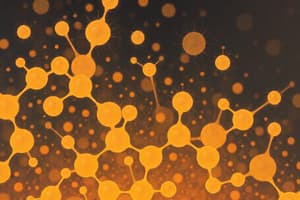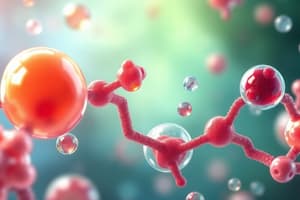Podcast
Questions and Answers
Which biomolecule serves as the primary source of energy for organisms and is composed of carbon, hydrogen, and oxygen?
Which biomolecule serves as the primary source of energy for organisms and is composed of carbon, hydrogen, and oxygen?
- Nucleic Acids
- Proteins
- Lipids
- Carbohydrates (correct)
If a person is lactose intolerant, which disaccharide would be difficult for them to digest?
If a person is lactose intolerant, which disaccharide would be difficult for them to digest?
- Sucrose
- Maltose
- Lactose (correct)
- Fructose
Which polysaccharide serves as a storage form of glucose in animals?
Which polysaccharide serves as a storage form of glucose in animals?
- Glycogen (correct)
- Cellulose
- Fructose
- Starch
A biologist is analyzing a sample from a plant cell wall. Which polysaccharide is most likely to be abundant in the sample?
A biologist is analyzing a sample from a plant cell wall. Which polysaccharide is most likely to be abundant in the sample?
If a food product is labeled as containing a high amount of triglycerides, which type of biomolecule is most abundant in the product?
If a food product is labeled as containing a high amount of triglycerides, which type of biomolecule is most abundant in the product?
Which type of lipid is a major component of cell membranes?
Which type of lipid is a major component of cell membranes?
Which biomolecule is responsible for the storage of genetic information and its transmission from one generation to the next?
Which biomolecule is responsible for the storage of genetic information and its transmission from one generation to the next?
During exercise, muscles require a readily available source of oxygen. Which protein within muscle tissue facilitates oxygen storage?
During exercise, muscles require a readily available source of oxygen. Which protein within muscle tissue facilitates oxygen storage?
Which protein provides structural support to hair, skin, and nails?
Which protein provides structural support to hair, skin, and nails?
In blood, what is the role of hemoglobin?
In blood, what is the role of hemoglobin?
In the context of biomolecules, what is the role of nucleotides?
In the context of biomolecules, what is the role of nucleotides?
Which nucleic acid directs the production of proteins?
Which nucleic acid directs the production of proteins?
A scientist discovers a new biomolecule. It contains a long chain of amino acids. Which class of biomolecules does the new molecule belong to?
A scientist discovers a new biomolecule. It contains a long chain of amino acids. Which class of biomolecules does the new molecule belong to?
Which of the following provides the body with insulation, energy storage, and cushioning for organs?
Which of the following provides the body with insulation, energy storage, and cushioning for organs?
A marathon runner relies on which stored polysaccharide in their muscles for a quick source of energy?
A marathon runner relies on which stored polysaccharide in their muscles for a quick source of energy?
Connective tissues such as tendons and ligaments derive their strength and flexibility from which fibrous protein?
Connective tissues such as tendons and ligaments derive their strength and flexibility from which fibrous protein?
Which carbohydrate is commonly referred to as 'blood sugar'?
Which carbohydrate is commonly referred to as 'blood sugar'?
Which disaccharide is formed when two glucose molecules are joined together?
Which disaccharide is formed when two glucose molecules are joined together?
Of the following, which is a function of sterols?
Of the following, which is a function of sterols?
Which type of protein is known for its exceptional strength and resistance to deformation and is often found in silk?
Which type of protein is known for its exceptional strength and resistance to deformation and is often found in silk?
Flashcards
Biomolecule
Biomolecule
Substances produced by cells and living organisms with a wide range of sizes, structures, and functions.
Carbohydrates
Carbohydrates
Organic compounds made of carbon, hydrogen, and oxygen that serve as the main energy source.
Monosaccharides
Monosaccharides
Simple sugars consisting of one saccharide unit, such as glucose, fructose, and galactose.
Disaccharides
Disaccharides
Signup and view all the flashcards
Polysaccharides
Polysaccharides
Signup and view all the flashcards
Lipids
Lipids
Signup and view all the flashcards
Triglycerides
Triglycerides
Signup and view all the flashcards
Phospholipids
Phospholipids
Signup and view all the flashcards
Sterols
Sterols
Signup and view all the flashcards
Proteins
Proteins
Signup and view all the flashcards
Keratin
Keratin
Signup and view all the flashcards
Fibroin/ Silk Protein
Fibroin/ Silk Protein
Signup and view all the flashcards
Collagen
Collagen
Signup and view all the flashcards
Myoglobin
Myoglobin
Signup and view all the flashcards
Hemoglobin
Hemoglobin
Signup and view all the flashcards
Nucleic Acids
Nucleic Acids
Signup and view all the flashcards
Nucleotides
Nucleotides
Signup and view all the flashcards
Deoxyribonucleic Acid (DNA)
Deoxyribonucleic Acid (DNA)
Signup and view all the flashcards
Ribonucleic Acid (RNA)
Ribonucleic Acid (RNA)
Signup and view all the flashcards
Study Notes
- Biomolecules are substances produced by cells and living organisms with diverse structures and functions.
Major Classes of Biological Macromolecules
Carbohydrates (Saccharides)
- Organic compounds that serve as the primary energy source for organisms.
- Composed of carbon, hydrogen, and oxygen.
Classification of Carbohydrates
Simple Sugars
Monosaccharides (One Saccharide)
- Glucose: Also known as dextrose or blood sugar.
- Fructose: Found in fruits and honey.
- Galactose: Found in milk and milk products.
Disaccharides (Two Saccharides)
- Sucrose: Found in common table sugar and sugarcane.
- Maltose: Found in malt.
- Lactose: Found in milk and milk products.
Complex Sugars
Polysaccharides (Many Saccharides)
- Starch (Amylose): A storage form of glucose in plants.
- Glycogen: A storage form of glucose in animals.
- Cellulose: A structural material in plant cell walls and wood fiber.
Lipids
- Lipids are biomolecules with varied structures.
- Lipids have hydrophobic properties (water-fearing).
- Examples include fats and oils.
Types of Lipids
Triglycerides (Fats)
- Comprise 95% of the fat in the food we consume.
- Commonly found in fried foods, vegetable oil, butter, and cheese.
Phospholipids
- Contain glycerol, two fatty acids, and a phosphate group.
- Make up cell membranes and lipid carrier molecules.
Sterols
- Found in tissues of animals and plants.
- Cholesterol is a well-known sterol in the body.
Proteins
- The most abundant organic compounds in living organisms, accounting for about 15% of the body's dry weight.
- The basic building block of proteins is amino acids.
Examples of Proteins
- Keratin: A structural protein found in hair, skin, and nails.
- Fibroin (Silk Protein): one of the strongest natural fibers with high resistance to deformation.
- Collagen: An insoluble fibrous protein found in connective tissues like tendons, ligaments, skin, cartilage, and the cornea of the eye.
- Myoglobin: Stores oxygen in muscles.
- Hemoglobin: Carries oxygen from the lungs to the bloodstream.
Nucleic Acids
- Organic compounds that store genetic information, which is transmitted from one generation to the next in living organisms.
- Made up of repeating units of monomers called nucleotides.
Components of Nucleotides
- Sugar molecule
- Phosphate group
- Nitrogenous base
Types of Nucleic Acids
Deoxyribonucleic Acid (DNA)
- Acts as a carrier for genetic information.
Ribonucleic Acid (RNA)
- Directs the production of proteins needed in living organisms.
Studying That Suits You
Use AI to generate personalized quizzes and flashcards to suit your learning preferences.




